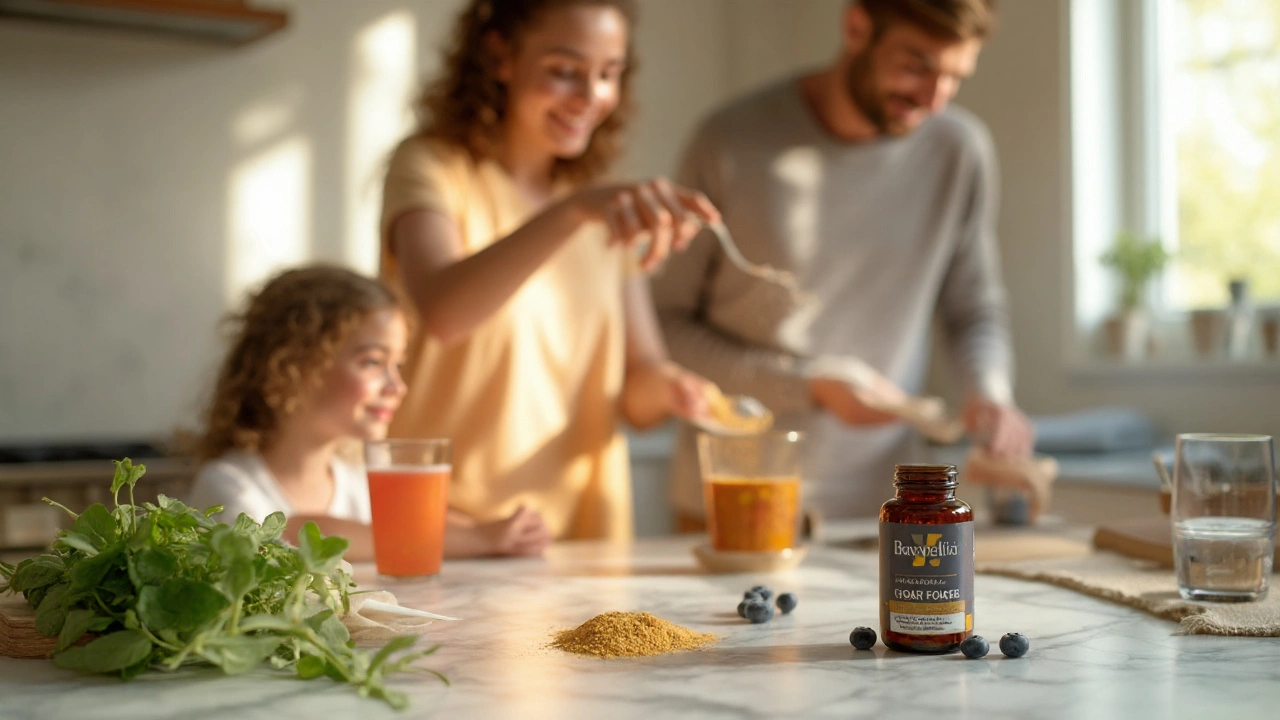Boswellia is a resin‑producing tree native to India and the Arabian Peninsula whose extract has been used for centuries to curb inflammation and support joint health. The bark and gum contain boswellic acids that act on cellular pathways linked to pain and swelling, earning Boswellia the nickname “King of Herbal Supplements.”
- Rapid reduction of joint discomfort
- Supports healthy gut lining
- Balances immune response without harsh side effects
- Works synergistically with other botanicals like turmeric
- Backed by modern clinical trials
How Boswellia Works at the Molecular Level
When you ingest Boswellia, the body extracts boswellic acids, a family of pentacyclic triterpenes that specifically block the 5‑lipoxygenase enzyme. This enzyme is a key driver of leukotriene production, chemicals that fan the flames of inflammation. By curbing leukotrienes, Boswellia lowers cytokine release, reduces cartilage degradation, and eases the perception of pain.
Beyond the 5‑LOX pathway, research shows boswellic acids also inhibit NF‑κB, a transcription factor that ramps up inflammatory gene expression. In practical terms, this dual blockade means both acute flare‑ups and chronic low‑grade inflammation can be tamed without the gastric irritation typical of synthetic NSAIDs.
Key Health Benefits Backed by Science
Four major benefit zones have emerged from clinical observations and randomized trials:
- Arthritis relief: Studies on patients with osteoarthritis report a 30‑40% improvement in joint stiffness after 8 weeks of 300mg Boswellia extract twice daily.
- Gut barrier support: In vitro work demonstrates that boswellic acids reinforce tight junction proteins, helping prevent leaky‑gut syndrome.
- Immune modulation: By dampening overactive Th17 cells, Boswellia can ease autoimmune flare‑ups without suppressing the entire immune system.
- Respiratory comfort: Traditional Ayurveda uses Boswellia incense to clear nasal passages; modern trials confirm reduced bronchial inflammation in asthma patients.
Comparing Boswellia to Other Natural Anti‑Inflammatories
People often wonder whether Boswellia is better than turmeric, ginger, or even low‑dose NSAIDs. The table below highlights the core differences.
| Entity | Active Component | Primary Benefit | Typical Dosage | Onset Time | Common Side Effects |
|---|---|---|---|---|---|
| Boswellia | Boswellic acids | Joint and gut inflammation | 300mg extract, 2×/day | 1‑2weeks | Mild stomach upset (rare) |
| Turmeric | Curcumin | Systemic inflammation | 500‑1000mg with piperine | 2‑4weeks | Stomach acidity, possible drug interaction |
| NSAIDs | Synthetic COX inhibitors | Pain relief | 200‑400mg as needed | 30minutes | Ulcers, kidney strain, cardiovascular risk |

Dosage Forms, Safety, and Potential Interactions
Boswellia is available as a hard‑capsule, softgel, liquid tincture, and even topical cream. Capsules are the most studied form because they deliver a standardized 65% boswellic acid content.
Safety data from over 1,000 trial participants show a low incidence of adverse effects. The most common complaint is a transient bitter aftertaste. People on blood‑thinners should monitor INR levels, as there’s a slight theoretical risk of enhanced anticoagulation.
Pregnant or nursing mothers should stick to culinary‑grade Boswellia (the resin used in incense) rather than high‑dose extracts, simply because the research pool is limited.
Integrating Boswellia into a Daily Routine
Here’s a simple 7‑day starter plan for someone with mild knee discomfort:
- Morning: Take one 300mg capsule with breakfast.
- Mid‑day: Add a few drops of Boswellia oil to a warm salad dressing.
- Evening: Perform a 10‑minute joint‑mobility routine (e.g., gentle knee bends) and finish with a second capsule.
- Weekend: Replace one capsule with a 30‑minute outdoor walk; the natural movement synergizes with Boswellia’s anti‑inflammatory action.
After two weeks, most users notice less stiffness and a smoother range of motion. If you’re already taking turmeric, combine the two at half the usual turmeric dose to avoid overlapping digestive upset.
Related Herbal Concepts and Next Steps
Boswellia sits within a broader family of adaptogenic herbs that help the body maintain balance under stress. Other members you might explore include:
- Ashwagandha - supports cortisol regulation and muscle recovery.
- Ginger - similar COX‑inhibiting properties, great for nausea.
- Cat’sclaw - immune‑modulating, useful for autoimmune flare‑ups.
Each of these herbs can be stacked with Boswellia, but start low and monitor how your body reacts. For a deeper dive, you could read about “Botanical Synergy in Joint Health” - a natural next topic after mastering Boswellia.

Frequently Asked Questions
How long does it take to feel the effects of Boswellia?
Most people notice reduced joint stiffness within 1‑2weeks of consistent dosing. Full therapeutic benefits, especially for chronic gut issues, may require 4‑8weeks.
Can I take Boswellia with my prescription NSAID?
Yes, but only under a doctor's watch. The combination can boost anti‑inflammatory power, yet it may increase the risk of stomach irritation in sensitive individuals.
Is Boswellia safe for long‑term use?
Long‑term studies up to 12months show good tolerability. Periodic breaks (2‑4weeks) are advised for people on blood thinners.
What dosage should I use for arthritis?
A common regimen is 300mg of standardized Boswellia extract, taken twice daily with meals. Adjust up to 600mg per dose only after consulting a health professional.
Does Boswellia interact with blood‑thinners?
There is limited evidence of a mild potentiation effect. If you’re on warfarin or similar drugs, monitor clotting parameters regularly.
Can I use Boswellia during pregnancy?
Stick to culinary‑grade Boswellia (the frankincense resin used in cooking) and avoid high‑dose extracts unless a practitioner advises otherwise.
Is there a difference between Boswellia serrata and Boswellia carterii?
Both species contain boswellic acids, but serrata generally has a higher 11‑keto‑beta‑boswellic acid (KBA) concentration, which is the most studied anti‑inflammatory component.








10 Comments
Sondra Johnson
September 24, 2025 AT 00:37Boswellia is straight-up magic in a capsule. I’ve been taking it for my knee arthritis for 6 months now - no more morning creaking like an old door. I used to rely on ibuprofen like it was oxygen, now I barely touch it. The fact that it doesn’t wreck your stomach? Chef’s kiss. And don’t even get me started on how it calms my gut flare-ups. It’s like my body finally got a chill pill.
Chelsey Gonzales
September 25, 2025 AT 01:12omg yes!! i started takin boswellia after my yoga teacher told me abt it and like… my back pain just… vanished? no joke. i thought it was gonna be another one of those ‘herbal hype’ things but nah. i even bought the oil and rub it on my knees before bed. smells like incense and feels like heaven. also, no more bloating after meals. witchcraft? maybe. science? prob.
MaKayla Ryan
September 26, 2025 AT 10:03Stop promoting third-world herbs like they’re FDA-approved medicine. This isn’t Ayurveda’s version of a miracle drug - it’s a glorified tree sap. You think a 300mg capsule is going to fix what Big Pharma can’t? Wake up. NSAIDs work fast. This takes weeks? That’s not healing, that’s waiting. And don’t even get me started on people mixing it with turmeric like it’s a smoothie. You’re just wasting money and time.
Kelly Yanke Deltener
September 27, 2025 AT 03:37I tried this after reading your post and I cried. Not because it worked - but because I finally felt like my body wasn’t betraying me. I’ve had RA for 12 years. I’ve been on everything. Methotrexate. Humira. Even that weird biologic that made me break out in hives. Boswellia didn’t cure me. But it gave me back my mornings. I can now pick up my kid without screaming. That’s not a supplement. That’s a gift. Thank you for sharing this.
Sarah Khan
September 28, 2025 AT 13:11The molecular mechanism here is fascinating - dual inhibition of 5-LOX and NF-κB is rare among botanicals. Most plant compounds hit one pathway, but boswellic acids are like precision-guided anti-inflammatories. What’s even more compelling is how it preserves gut integrity while suppressing inflammation. That’s the holy grail - reducing systemic inflammation without compromising mucosal barriers. Combine that with its synergy with curcumin and you’ve got a polypharmacological profile that rivals many pharmaceuticals. The only missing piece is long-term epigenetic data, which is still sparse. Still, this is one of the most elegantly documented herbal interventions I’ve seen in the last decade.
Kelly Library Nook
September 29, 2025 AT 17:47According to the clinical data cited, the sample sizes for the osteoarthritis trials range between 60–120 participants, with durations of 8–12 weeks. This falls short of the gold standard for chronic condition management, which typically requires cohorts exceeding 500 subjects over 6–12 months. Furthermore, the standardized extract (65% boswellic acids) is not universally available in commercial formulations - many over-the-counter products contain less than 30%. The assertion that it has ‘low incidence of adverse effects’ is misleading without specifying the percentage of participants reporting mild GI disturbances (which in one study was 12.7%). This post reads more like marketing copy than evidence-based analysis.
Crystal Markowski
September 30, 2025 AT 07:44If you're new to herbal supplements, start slow. One capsule a day with food. Give it 14 days. Track your pain levels, sleep quality, and digestion. You might be surprised. And if you’re combining it with turmeric, reduce the turmeric dose - they both can be a bit much on the stomach. This isn’t a quick fix, but it’s a gentle one. And if you’ve been burned by harsh meds before, this might be the kind of healing your body’s been asking for. You’ve got this.
Charity Peters
September 30, 2025 AT 11:29i tried it. my knees feel better. that’s it. no need to overthink it.
Faye Woesthuis
October 2, 2025 AT 11:12Anyone who takes this instead of real medicine is a fool. You’re risking joint damage for a placebo with a fancy name. Stop being gullible.
raja gopal
October 3, 2025 AT 01:21As someone from India where frankincense has been part of daily life for centuries, I’m happy to see this getting attention. My grandmother used to burn it during monsoon season - said it eased her arthritis. Now I take capsules, and yes, it helps. But don’t forget: the real power isn’t just in the extract. It’s in the tradition, the patience, and the way we listen to our bodies. No pill replaces rest. No supplement replaces movement. Boswellia? It’s a helper. Not a hero.